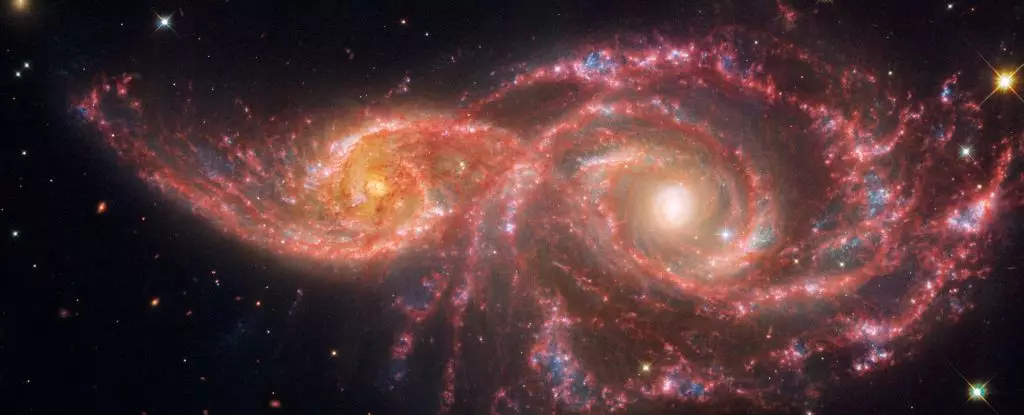In 1886, Friedrich Nietzsche poised a thought-provoking notion: “If you gaze for long into an abyss, the abyss gazes also into you.” Little could he have imagined a time when his metaphor would resonate with the profound realities unveiled by modern astronomy. Nearly 140 years later, we find ourselves peering into the cosmos, where an image revealing the tumultuous interaction of two galaxies, NGC 2207 and IC 2163, sparks a contemporary reinterpretation of his words. They appear to manifest as ominous eyes in the depths of space, inviting us to ponder our place within the vastness of the universe. This article delves into the intricate drama of galactic mergers, exploring the complexities underlying their formation and the stunning visuals that enhance our understanding of such cosmic events.
Galactic mergers are monumental processes that span millions of years, characterized by an elegant yet chaotic dance of mass and gravity. NGC 2207 and IC 2163 are currently locked in this celestial twirl, having previously brushed against one another eons ago. Their present engagement highlights a phase in a merger that bears little resemblance to a cataclysmic explosion; rather, it focuses on their gradual approach and interaction. As they orbit each other, gravitational forces pull and stretch their structures, distorting their spiral forms without yet sealing their fate into one unified entity.
Throughout this encounter, the gravitational attraction serves not just as a mechanical force but as an agent of brilliant evolution. These galaxies have already begun to shed their individual identities, displaying signs of transformation with burgeoning pockets of star formation—an indication that their conjunctive embrace is engendering a new epoch of stellar creation. The visualization of this spectacle is impeccably captured by the Hubble and JWST space telescopes, allowing viewers to glimpse the elaborate interplay between cosmic forces and the birth of radiant stars.
The interaction between NGC 2207 and IC 2163 ignites a stellar frenzy as compressed gas clouds within the galaxies undergo extreme turbulence. The catalyst for star formation lies within these clouds; as they collide and merge under increasing gravitational pressures, dense clumps are created. The collapse of these clumps leads to the emergence of “baby stars,” which begin a life-long journey of growth and expansion by “feeding” off the surrounding gas. In contrast to our relatively quiescent Milky Way, which produces only a handful of new stars each year, the two merging galaxies in question yield dozens of solar masses’ worth annually—a testimony to the richness of this cosmic environment.
However, this vigorous birth process is inherently tied to death—a brutal yet elegant axiom of the universe. The massive stars that form in these active regions exhibit short life spans and culminate their existence in spectacular supernova explosions, dispersing elements into space and providing raw materials for the next generation of stars. This cyclical dance of creation and destruction, visible in the celestial tapestry woven by newly formed stars, illustrates the eternal cycle of life written into the fabric of the cosmos.
The Hubble telescope captures this cosmic ballet through its ultraviolet imagery, showcasing areas where star formation flourishes in brilliant hues of pale blue. Meanwhile, JWST engages its capabilities by revealing detailed structures of dust that blanket both galaxies in intricate patterns. The scene thrusts us into a realm where science and art converge, providing not just a visual display but a deeper comprehension of galactic ecosystems, enhancing our understanding of the universe’s vastness and complexity.
In contemplating Nietzsche’s reflective insight, we may find added layers to his declaration—not only do we peer into the abyss, but we also unravel the compelling stories woven throughout its depths. As we navigate the cosmic landscape revealed through modern telescopes, we not only witness the enigmatic natures of galactic unions but also bear witness to an existence that transcends human limitations. These cosmic events compel us to reassess our significance in the timeline of the universe, offering a glimpse of the perpetual regeneration of matter and energy on a scale that dwarfs our own stories.
In this exploration of merging galaxies, NGC 2207 and IC 2163 serve as symbols of both connection and transformation, inviting reflections on the nature of existence itself. Through the lens of science and philosophy, we are reminded that the cosmos is not just an abyss but a magnificent tapestry of life, death, and rebirth, urging us to find beauty even in impermanence.


Leave a Reply